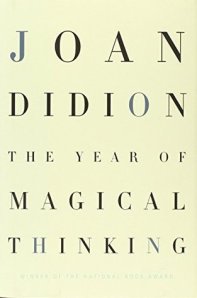
What is grief?
Joan Didion’s husband slumps over the dinner table. Heart attack. They’ve been together for four decades. She can’t imagine life without him. Now she doesn’t have a choice.
Life changes fast.
Life changes in the instant.
You sit down to dinner and life as you know it ends.
The question of self-pity.
So begins Didion’s year of magical thinking – a time in which grief digs its fingers into every part of her being and changes the way she thinks, the way she reacts, the way she perceives the world and herself.
What is transformation? What is the power of a wish?
I started reading The Year of Magical Thinking because I wanted to read The White Album but all copies were checked out of the library. For some reason, I had it in my head that it was a cheerful book – something helpful and funny and wry and bordering on self-help, like Amy Poehler’s Yes Please or Tina Fey’s Bossypants.
And it is helpful, and funny, and wry, and bordering on self-help. It’s just also heart-breakingly sad, right to the core. Magical Thinking isn’t about overcoming grief as much as it’s about dissecting it – separating its component parts and taking a good, hard look at how it works. There’s no doubt that John’s death has changed the way she sees the world, Didion says – but what does that mean?
She finds herself unable to give away his shoes, in case he comes back and needs them.
She recognises that this doesn’t make sense, but she puts the shoes back in the closet all the same.
“Geese had been observed reacting to such a death by flying and calling, searching until they themselves became disoriented and lost,” she writes. Likewise, Didion calls and searches, calls and searches.
As a writer and a journalist, Didion’s prose is bang-on. She studies medical texts and philosophical texts. She excerpts sections from her novels, and from John’s, and books she read in college. She carefully pieces together a patchwork image of grief, and of the person she has become through her grief. Her voice is frank and engaging, making for a book that reads conversationally – intimately.
It’s a powerful text. It’s a portrait of a marriage the same way Truth and Beauty by Ann Patchett is a portrait of a friendship. It’s a reminder that every love story is a ghost story. It’s like Joan Didion pulls you in for a warm hug but also cuts you deeply with a paring knife.
This post’s header is a cropped version of an image from Flickr user Incase, available for use and modification through Creative Commons.